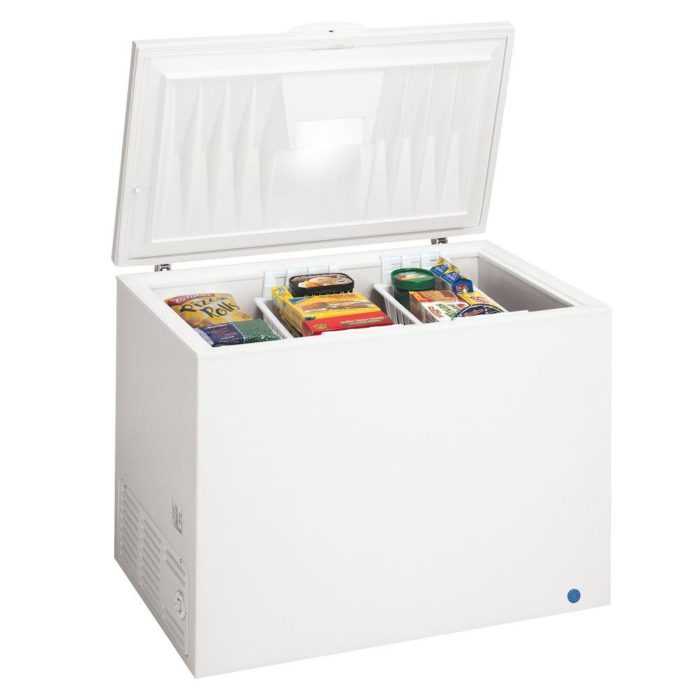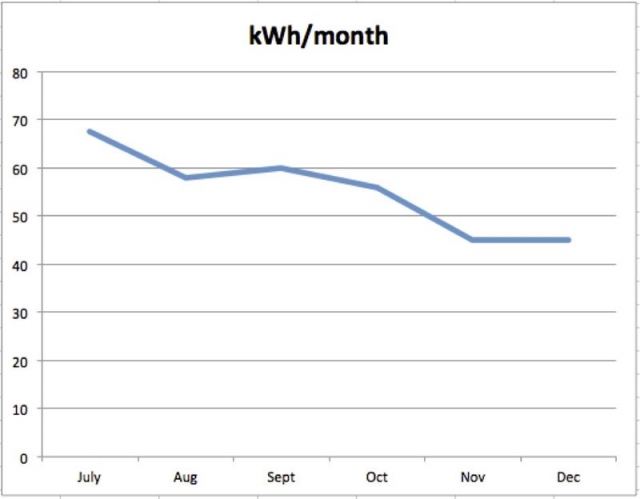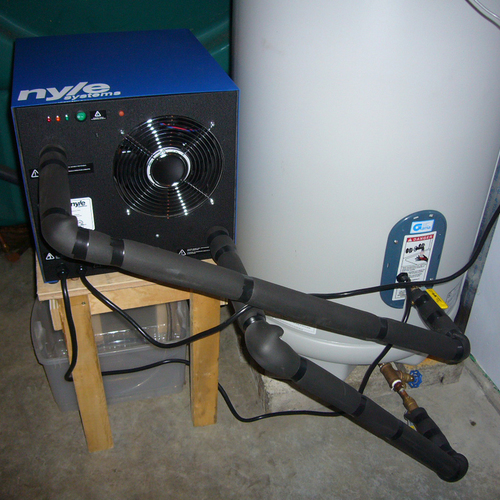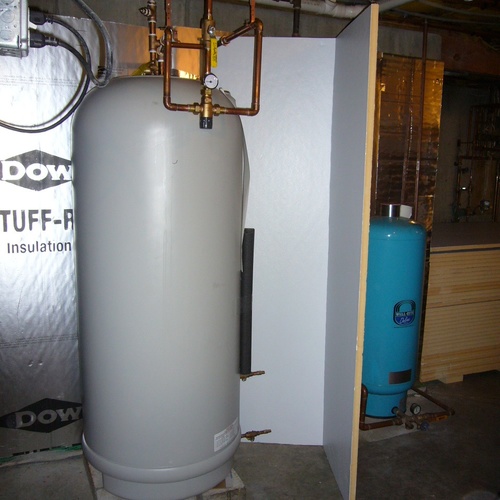
Image Credit: Frigidaire
We all know that residential heating load is highest in the winter and cooling load is highest in the summer. What’s a bit more subtle is how the seasons, and how we respond to them, change the loads on other household energy uses.
For example: this summer our basement temperature climbed above 70°F, and the incoming water temperature from the water pressure tank was in the mid to upper 60Fs. Here at year’s end, the basement temperature is in the mid-50Fs, and cold water temperature has dropped to as low as 48°F. Both of these changes since summer add load to the water heater, as it must provide more energy to get the lower temperature water up to 120°F, and the tank loses more heat to the colder basement. Here’s a graph of our domestic hot water (DHW) usage in gallons/day (GPD) and the corresponding kWh/day:
August through December DHW usage has been very constant at about 14 GPD, yet kWh/day has gone from just over 2 to just over 3.
Similarly, the 15-cubic-foot chest freezer is in the basement, and the refrigerator is on the main floor, both of which areas are cooler than they were in the summer. Here’s the kWh/month usage combined for both devices:
The load on the freezer and fridge drops because the spaces they are located in are cooler, so the temperature difference driving their heat gain is lower. In addition, the heat rejection components work more efficiently to reject heat to the surroundings when the air is cooler, so it takes less energy to meet the load.
Just as with the water heater, the two effects combine to change the energy usage, but in the case of the freezer and fridge, the energy usage goes down. That reduction isn’t as large as the increase in energy used by the heat pump water heater, unfortunately!
Again I find myself wishing for a fridge/freezer that rejects heat to a domestic hot water preheat tank, just as it’s done in commercial refrigeration. But energy will need to get more costly before that device appears on the market.
Marc Rosenbaum is director of engineering at South Mountain Company on the island of Martha’s Vineyard in Massachusetts. He writes a blog called Thriving on Low Carbon.
Weekly Newsletter
Get building science and energy efficiency advice, plus special offers, in your inbox.
















8 Comments
Water heater/refrigerator combis
The volume of hot water from combi's like that might (barely) be enough to serve kitchen needs. If a pretty-efficient 'merican style refrigerator uses 350kwh/year that's about 1.2 MMBTU (at most) delivered to the water, or about 3270BTU/day.
Assuming an 80F delta on incoming water that's about 5 gallons/day as an upper bound, which may be enough to serve a modest water-use home kitchen, but would be less than adequate for many/most.
In a heating dominated climate you'd have to discount for the amount of space heating that would be otherwise lost too. Yes there's still a net benefit, but whether it's a sufficient benefit to product-ize and sell with reasonable ROI for both the homeowner & manufacturer isn't so clear.
Do people still own chest freezers?
Green Advice
Do people still own chest freezers? What is green about owning a chest freezer? OK, my hunter friend does have a commercial walk in unit in his cellar stuffed with Adirondack critters. Cities are supposed to be the most sustainable way to habitate. Do all the new 300sqft condos have chest freezers? I visit the city and find a 1/4 stick of butter is all a fridge has.
Sustlainable living is tricky.
Marc, you are a great source of info. What the **** use is this blog? Really. Fun read anyway. Learning from failure is a big part of learning. I may have to touch a hot stove now.
Response to AJ Builder
AJ,
Q. "Do people still own chest freezers?"
A. Yes. In 2010, U.S. appliance manufacturers sold 1.95 million freezers in the U.S., of which 1.55 million units were chest freezers and 820 million units were upright freezers.
Source: http://business.highbeam.com/industry-reports/equipment/household-refrigerators-home-farm-freezers
A few thoughts
1) Am I reading the graphs correctly? If so calculated Energy factor seems miserable...
Input: 3 kwh / day = 10240 Btu / day
Output 14 gal * 8.333 lb / gal * (120-48)*F rise = 8400 Btu / day
EF = 8400/10240 = 0.82
Yuck...I figure a well insulated conventional storage electric resistance water heater would easily beat that. Marathons top out at 0.94 for 30 gallon models, and Marathon makes 15 and 20 gallon models that are unrated but likely would do even better since smaller models have lower standby loss.
2) We have a 7 CuFt chest freezer. We designed a new kitchen to accommodate it along with the usual top freezer. Despite several openings per day it requires defrosting only yearly and merely sips electricity.
3) Here is a link to CREWH - Combined Refrigerator Electric Water Heater. A prototype was built and tested but the program abandoned as refrigerators became steadily more efficient. Dana hits the nail upon the head, but I would add that refrigerators in actual use tend to consume about double what energy guide labels promise - users do pesky things like open the doors, make ice, and turn on the door heater to boil off condensate accumulating at gaskets
http://eec.ucdavis.edu/ACEEE/1994-96/1994/VOL03/019.PDF
I would like to explore recovering heat from refrigeration and air conditioning for water heating in the context of full service restaurants, but that's a discussion for another day.
As long as we are wishing for
As long as we are wishing for weird refrigerators, here's one:
Connect a small supply and return duct from the outside (3/4" PEX should work)
Now turn on a tiny blower instead of the compressor whenever it's below 39F outside.
Reply to Curt K
Curt, full service sit-down restaurants with dishwashers can benefit from water heat reclaim with a reasonable payback period. Therma-Stor been designing/manufacturing/applying water heat reclaim units since the 1970's.
About 20 years ago we applied heat pump water heaters to these applications and found them to be a good fit with a reasonable pay back period as well. These were commercial heat pump water heaters with more emphasis on the heat pump than the current crop of residential heat pump water heaters available today.
Idea for Kevin
Kevin, your general concept is actually quite practical and has been successfully implemented. Sunfrost manufactured passive assist refreigerators for cold climate regions in the 1980s using a passive heat pipe technique, see http://sunfrost.com/blog/ entry dated Sept. 21, 2010. Amory Lovins' house in Snowmass, CO uses one. Sunfrost more recently installed an updated version of this refrigerator at the Cold Climate Housing Research Center, using a heat pipe measuring only one quarter inch diameter, and featuring a thermostatic control to prevent the refrigerator box from becoming too cold. Sunfrost notes they are considering re-introducing this model to the marketplace if sufficient demand appears.
Response to Jan Juran
Jan,
The Sunfrost refrigerator uses a passive thermosyphon loop of copper tubing that carries refrigerant -- rather than using an outdoor air duct as Kevin suggested.
The problem with the outdoor air duct is that it will freeze your lettuce, especially when the outdoor temperature is below zero F.
My neighbor and friend Bill Gessner has one of the old Sunfrosts from the 1980s with a passive thermosyphon loop. It's still working just fine. When I tried to buy one a year after Bill bought his, Sunfrost said they stopped making the passive loop.
Log in or create an account to post a comment.
Sign up Log in